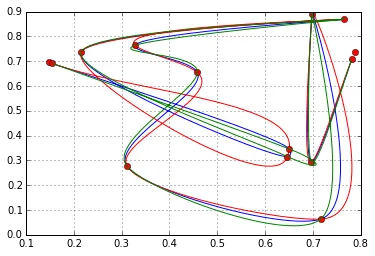正如之前所提到的,对于Catmull-Rom曲线来说您需要4个点,而端点是一个问题。我正在考虑将它们应用在自然三次样条线之外(在我的应用程序中,潜在的超出已知数据范围的过冲是不切实际的)。与@denis的代码类似,这里有一些可能会对您有所帮助的东西(注意几点:1)该代码只是随机生成点,我相信您可以使用被注释掉的示例来使用您自己的数据。 2)我创建了扩展端点,在第一个/最后两个点之间保留斜率 - 使用域的任意距离的1%。 3)我包括均匀、向心和弦向结参数化以进行比较):

import numpy
import matplotlib.pyplot as plt
get_ipython().magic(u'pylab inline')
def CatmullRomSpline(P0, P1, P2, P3, a, nPoints=100):
"""
P0, P1, P2, and P3 should be (x,y) point pairs that define the Catmull-Rom spline.
nPoints is the number of points to include in this curve segment.
"""
P0, P1, P2, P3 = map(numpy.array, [P0, P1, P2, P3])
alpha = a
def tj(ti, Pi, Pj):
xi, yi = Pi
xj, yj = Pj
return ( ( (xj-xi)**2 + (yj-yi)**2 )**0.5 )**alpha + ti
t0 = 0
t1 = tj(t0, P0, P1)
t2 = tj(t1, P1, P2)
t3 = tj(t2, P2, P3)
t = numpy.linspace(t1,t2,nPoints)
t = t.reshape(len(t),1)
A1 = (t1-t)/(t1-t0)*P0 + (t-t0)/(t1-t0)*P1
A2 = (t2-t)/(t2-t1)*P1 + (t-t1)/(t2-t1)*P2
A3 = (t3-t)/(t3-t2)*P2 + (t-t2)/(t3-t2)*P3
B1 = (t2-t)/(t2-t0)*A1 + (t-t0)/(t2-t0)*A2
B2 = (t3-t)/(t3-t1)*A2 + (t-t1)/(t3-t1)*A3
C = (t2-t)/(t2-t1)*B1 + (t-t1)/(t2-t1)*B2
return C
def CatmullRomChain(P,alpha):
"""
Calculate Catmull Rom for a chain of points and return the combined curve.
"""
sz = len(P)
C = []
for i in range(sz-3):
c = CatmullRomSpline(P[i], P[i+1], P[i+2], P[i+3],alpha)
C.extend(c)
return C
Points = numpy.random.rand(10,2)
x1=Points[0][0]
x2=Points[1][0]
y1=Points[0][1]
y2=Points[1][1]
x3=Points[-2][0]
x4=Points[-1][0]
y3=Points[-2][1]
y4=Points[-1][1]
dom=max(Points[:,0])-min(Points[:,0])
rng=max(Points[:,1])-min(Points[:,1])
pctdom=1
pctdom=float(pctdom)/100
prex=x1+sign(x1-x2)*dom*pctdom
prey=(y1-y2)/(x1-x2)*(prex-x1)+y1
endx=x4+sign(x4-x3)*dom*pctdom
endy=(y4-y3)/(x4-x3)*(endx-x4)+y4
print len(Points)
Points=list(Points)
Points.insert(0,array([prex,prey]))
Points.append(array([endx,endy]))
print len(Points)
a=0.
c = CatmullRomChain(Points,a)
x,y = zip(*c)
plt.plot(x,y,c='green',zorder=10)
a=0.5
c = CatmullRomChain(Points,a)
x,y = zip(*c)
plt.plot(x,y,c='blue')
a=1.
c = CatmullRomChain(Points,a)
x,y = zip(*c)
plt.plot(x,y,c='red')
px, py = zip(*Points)
plt.plot(px,py,'o',c='black')
plt.grid(b=True)
plt.show()
Points
